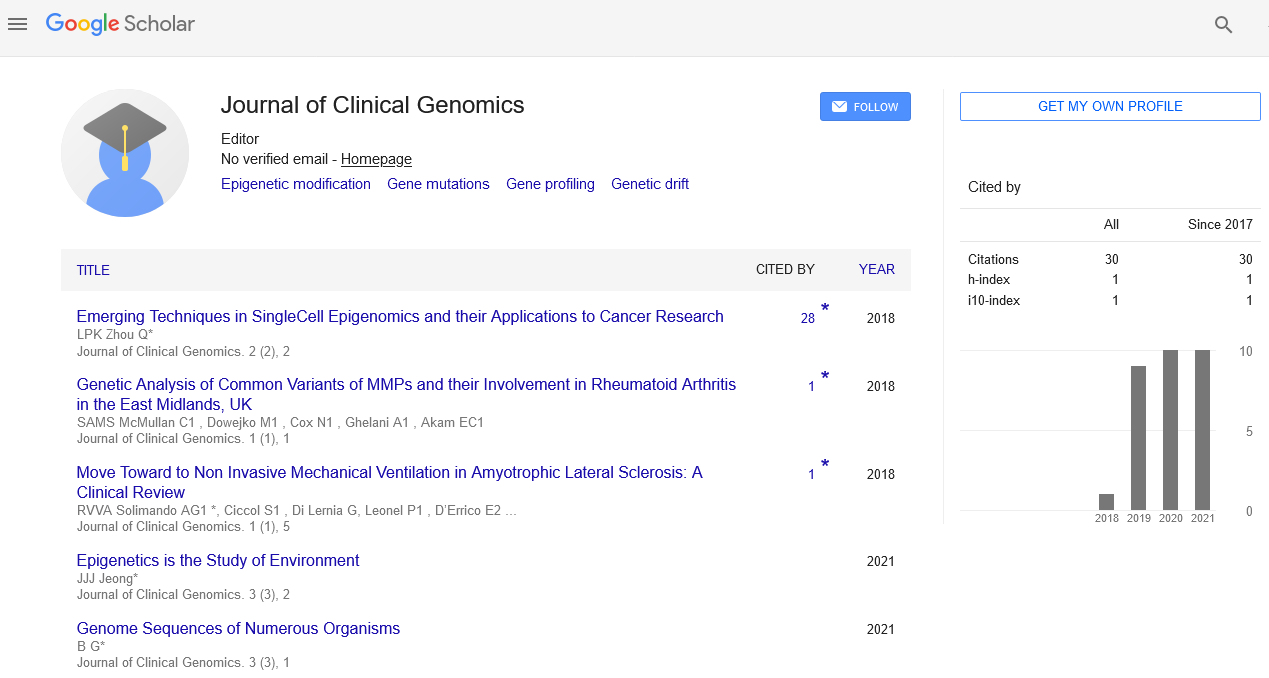Opinion Article, J Clin Genom Vol: 5 Issue: 1
Metagenomics to Investigate Elusive Elements of Microbes
Marques Julianne*
1Department of Medical Microbiology, Leiden University Medical Center, Leiden, The Netherlands
*Corresponding Author: Marques Julianne
Department of Medical Microbiology,
Leiden University Medical Center, Leiden, The Netherlands
E-mail: marqjulian@lumc.nl
Received date: 03 February, 2023, Manuscript No. JCG-23-96324;
Editor assigned date: 07 February, 2023, PreQC No. JCG-23-96324 (PQ);
Reviewed date: 21 February, 2023, QC No. JCG-23-96324;
Revised date: 28 February, 2023, Manuscript No. JCG-23-96324 (R);
Published date: 07 March, 2023, DOI: 10.4172/JCG.1000121
Citation: Julianne M (2023) Metagenomics to Investigate Elusive Elements of Microbes. J Clin Genom 5:1.
Description
Microbes, including bacteria, viruses, fungi and archaea, are ubiquitous and play vital roles in various ecosystems, from soil to oceans to human bodies. Traditional microbiological methods have limitations in studying the vast microbial diversity, as many microbes cannot be cultured or are difficult to cultivate in the laboratory. Metagenomics, a powerful approach that bypasses the need for cultivation, has revolutionized our understanding of microbial communities by allowing the direct study of microbial DNA from environmental samples.
Microbial diversity
Metagenomics has transformed our perception of microbial diversity by revealing the incredible richness and complexity of microbial communities. Through metagenomic sequencing, the analysts can obtain Deoxyribonucleic Acid (DNA) fragments from environmental samples and assemble them into complete or partial microbial genomes. This has led to the discovery of numerous novel microbial taxa, including previously unknown bacterial phyla, and has provided insights into their ecological roles and evolutionary relationships. Metagenomics has also revealed the existence of microbial dark matter, a vast diversity of uncultured and uncharacterized microbes that cannot be easily studied using traditional methods. By unveiling about microbial diversity, metagenomics has expanded the understanding of the microbial world and its potential impacts on various ecosystems.
Microbial functionality
Metagenomics not only provides insights into the diversity of microbes, but also reveals their functional capabilities. Functional metagenomics involves the direct sequencing of environmental DNA to identify genes and pathways responsible for specific biological functions. This approach has shed light on the metabolic potential and functional diversity of microbial communities, including their roles in nutrient cycling, biodegradation of pollutants, production of bioactive compounds, and other ecological processes. Functional metagenomics has also enabled the discovery of novel enzymes and biocatalysts with industrial applications, providing valuable resources for biotechnology and bioengineering.
Microbial interactions
Metagenomics has also advanced our understanding of microbial interactions within communities, including their cooperative or competitive relationships, and their roles in shaping community structure and function. By analyzing metagenomic data, analysts can identify genes and pathways associated with microbial interactions, such as those involved in quorum sensing, biofilm formation, and horizontal gene transfer. Metagenomics has also allowed the study of viral interactions with microbial communities, including viral-host interactions, viral diversity, and the role of viruses in shaping microbial communities. These insights have provided a deeper conception on the complex dynamics and interplay among different microbes within a community, and how they contribute to ecosystem functioning.
Challenges and future directions
While metagenomics has revolutionized our understanding of microbial diversity and functionality, there are still challenges to overcome. Technical limitations, such as biases in DNA extraction, sequencing, and assembly, can affect the accuracy and completeness of metagenomic data. The interpretation and functional annotation of metagenomic data can be complex and challenging; requiring advanced computational tools and databases. Moreover, ethical considerations, such as data sharing and privacy concerns, need to be addressed in metagenomic analysis involving human-associated microbiota.
Despite these challenges, metagenomics holds great promise for the future. Advances in sequencing technologies, bioinformatics tools, and data integration approaches are continually improving the accuracy and depth of metagenomic studies. These metagenomics also has the potential to contribute to various fields, such as personalized medicine, environmental monitoring, and biotechnology, by providing valuable insights into the functional capabilities of microbial communities and their interactions with their environment.
Conclusion
Metagenomics has emerged as a powerful tool for investigating the elusive elements of microbes, including their diversity and functionality. By unveiling about microbial communities, metagenomics has transformed our understanding of the microbial world and its impact on various ecosystems. It has revealed the incredible richness and complexity of microbial diversity, uncovered the functional potential of microbial communities, and provided insights into microbial interactions and dynamics.
 Spanish
Spanish  Chinese
Chinese  Russian
Russian  German
German  French
French  Japanese
Japanese  Portuguese
Portuguese  Hindi
Hindi 